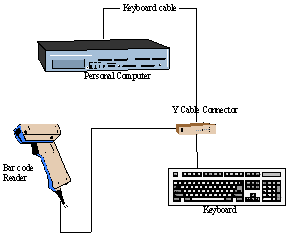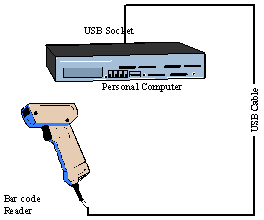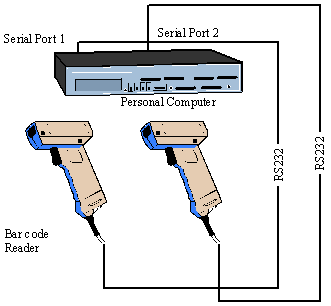This type of barcode reader is attached through the keyboard interface, the barcode reader sends data in scan codes (the codes used by IBM PC keyboards), exactly as you pressed the keys in the keyboard. It is called “Wedge reader” because they physically wedge between the keyboard and computer, as depicted the diagram below.
Since the barcode reader can use the power from the keyboard cable, no external power is needed. On the other side, this configuration is not designed for communication which has a distance more than 25 feet.

A special type of keyboard wedge barcode readers is the one using now-popular USB technology. It is similar to the keyboard wedge reader above, but uses the USB interface. No driver is needed too and the data is placed directly in the keyboard buffer. It is convenient to use with a notebook because the latter does not have an external keyboard.
Only Windows 98 or above platforms (including Windows ME, 2000 and XP) supports USB configuration. The OS treats the reader as a USB keyboard and automatically places the input in the keyboard buffer.
Keyboard Wedge interface is very simple to use. However, you must point the cursor to the correct input box and make sure that the cursor always stay in the right place before you press scan button. Theoretically a host computer can connect multiple barcode readers using this configuration, but the application has no knowledge about where the data comes from. Since the barcode reader receives power from the computer, this type of configuration does not need external power. The old application does not need to be modified to accommodate this configuration.

The barcode reader is connected to one of the serial ports of the computer. Software is needed to retrieve the information. It can be done in your application, or you place some programs coming with the barcode reader who simply reads the data and place them in the keyboard buffer. The communication takes the standard RS232 or RS432. An external power adapter is required for operation, and the distance can be as far as 250 feet. A host computer can connect as many barcode readers as the number of serial ports.
Windows provide a COM component called MSCOMM. Using this
COM component
your application retrieve the data from the OnComm handler. Win32 also
provides serial communication APIs but this method requires advanced
skills.

This type of barcode reader has memory powered by battery. Usually it also has keyboard, LCD display and is programmable. The data is stored in the memory first and then dumped into the computer via a dock station. The data is usually transmitted in a comma-delimited text file format. The dock station also acts a recharge station.
Under this configuration a RF base station is connected to the computer through keyboard wedge or serial interfaces. The barcode reader communicates with the base station via radio frequency. The transmission rates are in the 1200 to 4800 baud range. The battery usually lasts much longer than the portable batch readers.

